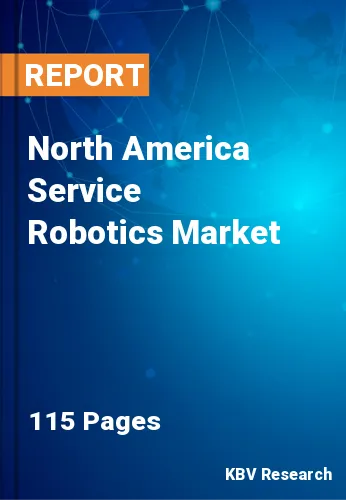The North America Service Robotics Market would witness market growth of 22.4% CAGR during the forecast period (2022-2028).
A service robot streamlines and performs a variety of helpful tasks for humans or equipment, with the exception of commercial automation applications. When compared to industrial robots, professional service robots are very different in terms of shape and function. Service robots comprise the ability to automate menial, time-consuming, or repetitive chores, allowing humans to focus on higher-level cognitive tasks. Personal service robots, on the other hand, are consumer-facing robots that automate duties in the house. Service robots also include self-cleaning window cleaners and vacuum cleaners.
High per capita income, continuous research projects, an aging population, and a labor shortage due to strict immigration regulations are all factors fueling the service robotics market across the United States. According to the Organization for Economic Cooperation and Development, the United States has the greatest average residential net adjusted per capita disposable income. As a result, demand for expensive surgical robots is anticipated to increase. In addition, incomes in the United States are high and have been steadily rising over time.
Moreover, as a result of the high income of the regional population, it's expected that demand for service robots in the United States would surge, particularly for residential applications. Further, because of its robust agriculture industry and several free trade agreements, Mexico can provide a substantial growth prospect for service robots. In the healthcare industry, service robotics is becoming more common. They are utilized in healthcare for a variety of reasons, including assisting in patient care procedures. Diverse countries in this region have different healthcare systems. The private sector accounts for a broad majority of healthcare providers in the United States.
The US market dominated the North America Service Robotics Market by Country in 2021, and would continue to be a dominant market till 2028; thereby, achieving a market value of $42,307 million by 2028. The Canada market is estimated to grow at a CAGR of 25.2% during (2022 - 2028). Additionally, The Mexico market would witness a CAGR of 24.1% during (2022 - 2028).
Based on Application, the market is segmented into Domestic, Medical, Public Relation, Entertainment, Education, & Personal, Inspection & Maintenance, Field, Logistics, Defense, Rescue, & Security, Construction & Demolition, Marine, and Others. Based on Environment, the market is segmented into Ground, Aerial, and Marine. Based on Type, the market is segmented into Professional and Personal & Domestic. Based on Component, the market is segmented into Hardware and Software. Based on Hardware Type, the market is segmented into Sensors, Cameras, Power Supply, Control Systems, Airframes, Navigation Systems, Propulsion System & Actuator, and Others. Based on countries, the market is segmented into U.S., Mexico, Canada, and Rest of North America.
Free Valuable Insights: The Global Service Robotics Market is Estimated to reach $168.6 Billion by 2028, at a CAGR of 23.1%
The market research report covers the analysis of key stake holders of the market. Key companies profiled in the report include Kuka AG, Northrop Grumman Corporation, Intuitive Surgical, Inc., iRobot Corporation, General Electric (GE) Co., Cyberdyne, Inc., Daifuku Co., Limited, SoftBank Robotics Group Corporation, Tetra Laval International S.A., and Neato Robotics, Inc.
By Application
By Environment
By Type
By Component
By Country
Our team of dedicated experts can provide you with attractive expansion opportunities for your business.

